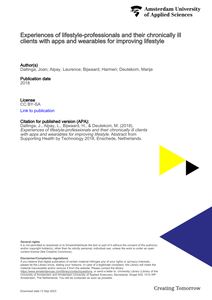This exploratory study aims to obtain a first impression of the wishes and needs of employees on the use of wearables at work for health promotion. 76 employ-ees with a mean age of 40 years old (SD ±11.7) filled in a survey after trying out a wearable. Most employees see the potential of using wearable devices for workplace health promotion. However, according to employees, some negative aspects should be overcome before wearables can effectively contribute to health promotion. The most mentioned negative aspects were poor visualization and un-pleasantness of wearing. Specifically for the workplace, employees were con-cerned about the privacy of data collection.
DOCUMENT

This exploratory study aims to obtain a first impression of the wishes and needs of employees on the use of wearables at work for health promotion. 76 employ-ees with a mean age of 40 years old (SD ±11.7) filled in a survey after trying out a wearable. Most employees see the potential of using wearable devices for workplace health promotion. However, according to employees, some negative aspects should be overcome before wearables can effectively contribute to health promotion. The most mentioned negative aspects were poor visualization and un-pleasantness of wearing. Specifically for the workplace, employees were con-cerned about the privacy of data collection.
LINK
The pervasiveness of wearable technology has opened the market for products that analyse running biomechanics and provide feedback to the user. To improve running technique feedback should target specific running biomechanical key points and promote an external focus. Aim for this study was to define and empirically test tailored feedback requirements for optimal motor learning in four consumer available running wearables. First, based on desk research and observations of coaches, a screening protocol was developed. Second, four wearables were tested according to the protocol. Third, results were reviewed, and four experts identified future requirements. Testing and reviewing the selected wearables with the protocol revealed that only two less relevant running biomechanical key points were measured. Provided feedback promotes an external focus of the user. Tailoring was absent in all wearables. These findings indicate that consumer available running wearables have a potential for optimal motor learning but need improvements as well.
DOCUMENT

This exploratory study aims to obtain a first impression of the wishes and needs of employees on the use of wearables at work for health promotion. 76 employ-ees with a mean age of 40 years old (SD ±11.7) filled in a survey after trying out a wearable. Most employees see the potential of using wearable devices for workplace health promotion. However, according to employees, some negative aspects should be overcome before wearables can effectively contribute to health promotion. The most mentioned negative aspects were poor visualization and un-pleasantness of wearing. Specifically for the workplace, employees were con-cerned about the privacy of data collection.
DOCUMENT

Injuries and lack of motivation are common reasons for discontinuation of running. Real-time feedback from wearables can reduce discontinuation by reducing injury risk and improving performance and motivation. There are however several limitations and challenges with current real-time feedback approaches. We discuss these limitations and challenges and provide a framework to optimise real-time feedback for reducing injury risk and improving performance and motivation. We first discuss the reasons why individuals run and propose that feedback targeted to these reasons can improve motivation and compliance. Secondly, we review the association of running technique and running workload with injuries and performance and we elaborate how real-time feedback on running technique and workload can be applied to reduce injury risk and improve performance and motivation. We also review different feedback modalities and motor learning feedback strategies and their application to real-time feedback. Briefly, the most effective feedback modality and frequency differ between variables and individuals, but a combination of modalities and mixture of real-time and delayed feedback is most effective. Moreover, feedback promoting perceived competence, autonomy and an external focus can improve motivation, learning and performance. Although the focus is on wearables, the challenges and practical applications are also relevant for laboratory-based gait retraining.
DOCUMENT

Professionals and clients see the potential of apps and wearables in supporting an active lifestyle. However, they are not yet widely used due to barriers such as limitations of current apps and concerns about the use by clients. Future research ideas: • Gain more insight into the factors that explain the acceptance and use of these technologies for both professionals and clients. • Finding out how professionals can be supported in using apps and wearables.
DOCUMENT

Occupational stress can cause health problems, productivity loss or absenteeism. Resilience interventions that help employees positively adapt to adversity can help prevent the negative consequences of occupational stress. Due to advances in sensor technology and smartphone applications, relatively unobtrusive self-monitoring of resilience-related outcomes is possible. With models that can recognize intra-individual changes in these outcomes and relate them to causal factors within the employee's context, an automated resilience intervention that gives personalized, just-in-time feedback can be developed. This paper presents the conceptual framework and methods behind the WearMe project, which aims to develop such models. A cyclical conceptual framework based on existing theories of stress and resilience is presented as the basis for the WearMe project. The operationalization of the concepts and the daily measurement cycle are described, including the use of wearable sensor technology (e.g., sleep tracking and heart rate variability measurements) and Ecological Momentary Assessment (mobile app). Analyses target the development of within-subject (n=1) and between-subjects models and include repeated measures correlation, multilevel modelling, time series analysis and Bayesian network statistics. Future work will focus on further developing these models and eventually explore the effectiveness of the envisioned personalized resilience system.
DOCUMENT
